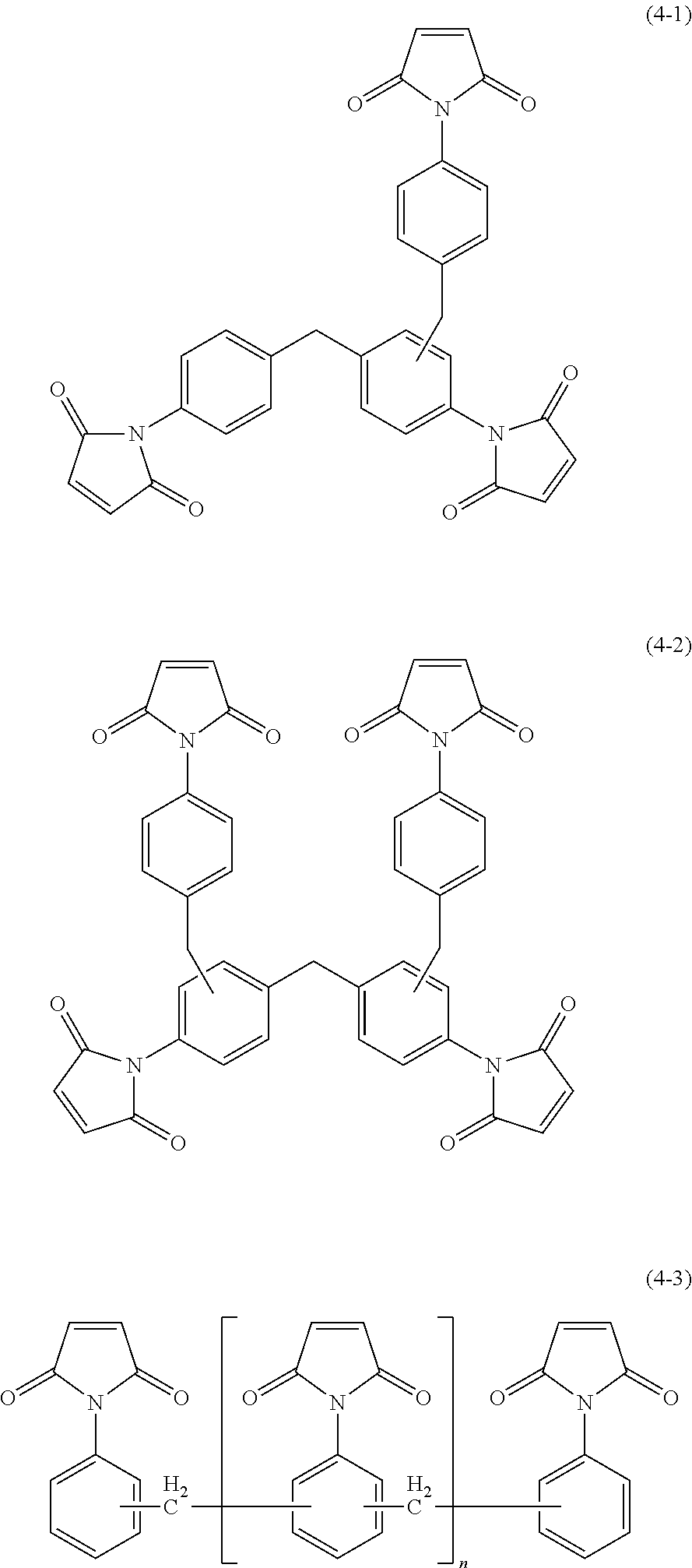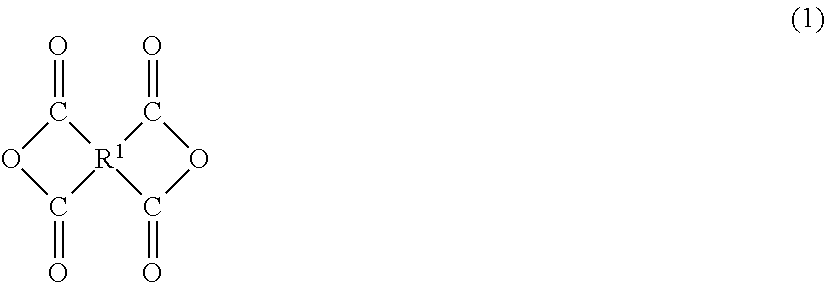Thermosetting polyimide resin composition, cured product, and adhesive
a technology of thermosetting polyimide resin and composition, applied in the direction of adhesives, etc., can solve the problems of difficult application of adhesive adhesive undergoes a change in adhesive property, and the adhesive is difficult to apply to a base having a low heat-resistance temperature, etc., to achieve excellent safety and health, short drying time, and reduced solvent discharge
- Summary
- Abstract
- Description
- Claims
- Application Information
AI Technical Summary
Benefits of technology
Problems solved by technology
Method used
Image
Examples
synthesis example 1
[0125]
[0126]1,2,4,5-Cyclohexanetetracarboxylic dianhydride (HPMDA, product of Mitsubishi Gas Chemical Company, Inc.) (58.520 g, 0.261 mol) and ethylene oxide-propylene oxide copolymer bis(2-aminopropyl) ether (trade name: Jeffamine ED-900, product of Mitsui Fine Chemical Inc., molecular weight: 966.6 (calculated from amine value), in formula (8), a+c=2.5 (theoretical value), b=15.5 (theoretical value)) (315.418 g, 0.326 mol) were added to a 500-mL five-neck round-bottom flask equipped with a thermometer, a stirrer, a nitrogen feed tube, a dropping funnel having a side tube, a Dean-Stark apparatus, and a cooling tube under a stream of nitrogen at 70° C. The resultant mixture was heated to 200° C. with stirring at 200 rpm, and imidization reaction was carried out for three hours. The thus-produced water (9.30 g) was separated by means of the Dean-Stark apparatus.
[0127]Three hours later, termination of distillation of water was confirmed, and then the residual liquid was cooled to ambi...
preparation example 1
[0128]
[0129]A maleimide composition (trade name: BMI-2300, product of Daiwa Fine Chemicals Co., Ltd.) (37.38 g) and 1,3-dioxolane (100 g) were added to a 500-mL five-neck flask equipped with a thermometer, a stirrer, a nitrogen feed tube, a dropping funnel having a side tube, a Dean-Stark apparatus, and a cooling tube under a stream of nitrogen, and the resultant mixture was stirred at room temperature for one hour for complete dissolution, to thereby prepare a solution B1.
example 1
[0130]The entire amount of the polyimide (a1) produced in Synthesis Example 1 (solution A) and the entire amount of the solution B1 prepared in Preparation Example 1 were added to a 500-mL five-neck flask equipped with a thermometer, a stirrer, a nitrogen feed tube, a dropping funnel having a side tube, and a cooling tube under a stream of nitrogen, and the resultant mixture was stirred at room temperature (25° C.) for one hour for complete dissolution, to thereby produce a thermosetting polyimide resin composition 1 containing 1,3-dioxolane (100% as a low-boiling-point solvent) and having a nonvolatile content of 80 wt. %. In the thermosetting polyimide resin composition 1, the amount of BMI-2300 (i.e., maleimide composition) is 10 parts by mass on the basis of 100 parts by mass of the polyimide (a1).
[0131]Subsequently, the thermosetting polyimide resin composition 1 was applied to an aluminum plate (150 mm×150 mm, thickness: 1 mm) placed on a hot plate maintained at 80° C. so that...
PUM
| Property | Measurement | Unit |
|---|---|---|
| temperature | aaaaa | aaaaa |
| temperature | aaaaa | aaaaa |
| temperature | aaaaa | aaaaa |
Abstract
Description
Claims
Application Information
 Login to View More
Login to View More - R&D
- Intellectual Property
- Life Sciences
- Materials
- Tech Scout
- Unparalleled Data Quality
- Higher Quality Content
- 60% Fewer Hallucinations
Browse by: Latest US Patents, China's latest patents, Technical Efficacy Thesaurus, Application Domain, Technology Topic, Popular Technical Reports.
© 2025 PatSnap. All rights reserved.Legal|Privacy policy|Modern Slavery Act Transparency Statement|Sitemap|About US| Contact US: help@patsnap.com



